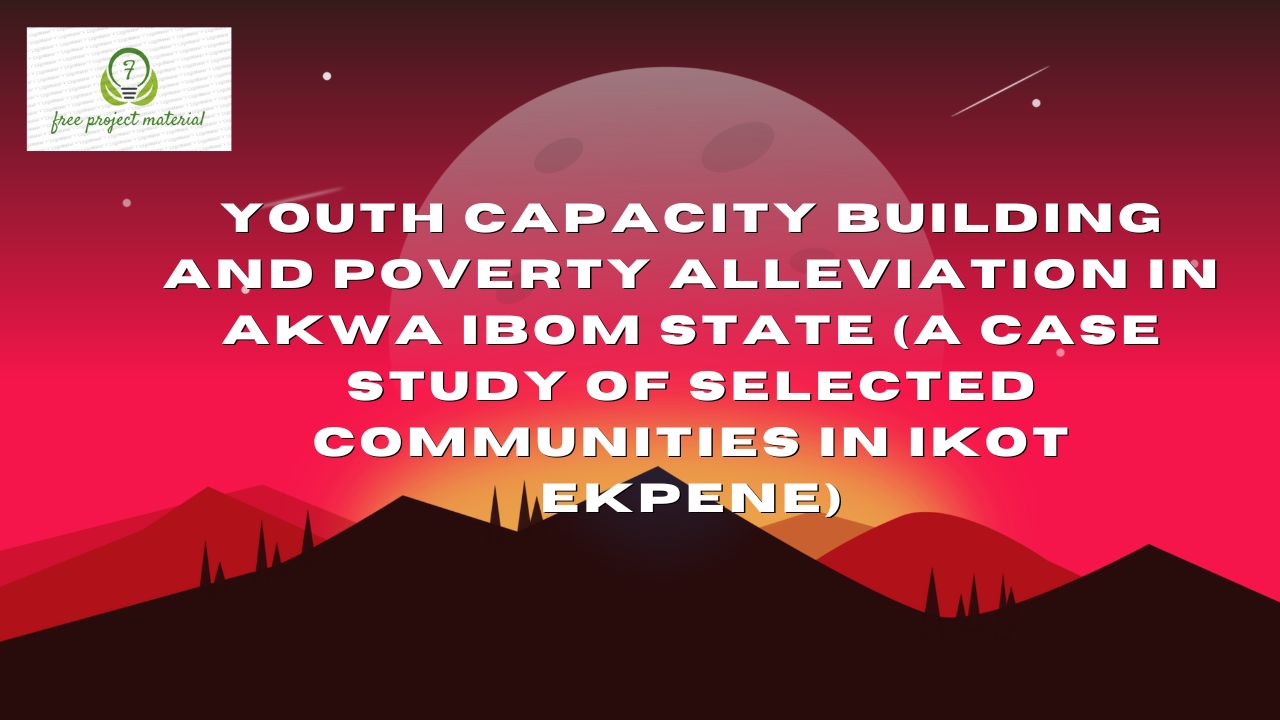ABSTRACT
This research work focused on Youth Capacity Building and Poverty Alleviation in Akwa Ibom State (A case study of selected communities in Ikot Ekpene Local Government Area). To achieve the research objectives, the study made use of survey research design. Taro vamene formular was used to select ninety two (92) respondents as sample size for the study. The instrument of data collection was self- developed questionnaire and the forms were personally administered. Hypotheses were formulated to guide the study and the data were analyzed using chi-square statistical tool. The findings revealed that there is significant relationship between conducting training needs assessment and poverty alleviation. That there is significant relationship between capacity development and poverty alleviation. That there is significant relationship between policy development and poverty alleviation. And there is significant relationship between competency and skill development and poverty alleviation. Useful recommendations were offered such as training needs assessment should be conducted to determine the best training to administer to youths in other to build their capacity. Akwa Ibom State Government should implement policies that affect the capacity development of the youths to be independent. And skill acquisition programmes should be conducted regularly to help in the capacity development of youths.
LIST OF TABLES
Table 3.1.1 Sample size Distribution- – – – 42
Table 4.2.1 A Observed Frequency Table for Hypothesis One- – 52
Table 4.2.1 B Expected Frequency Table for Hypothesis One- – 53
Table 4.2.1 C Comparison of observed with the Frequencies for Hypothesis One – – – – – – 54
Table 4.2.2 A Observed Frequency table for Hypothesis Two- 55
Table 4.2.2 B Expected Frequency Table for Hypothesis Two- 56
Table 4.2.2 C Comparison of observed Frequency with the expected Frequencies for Hypothesis Two – – 56
Table 4.2.3. A Observed Frequency table for Hypothesis Three – 57
Table 4.2.3. B Expected Frequency Table for Hypothesis Three – 58
Table 4.2.3 C Comparison of observed Frequency with the expected Frequencies for Hypothesis – – – – 58
Table 4.2.4 A Observed Frequency table for Hypothesis Four – 60
Table 4.2.4 B Expected Frequency Table for Hypothesis Four – 60
Table 4.2.4 C Comparison of observed Frequency with the expected Frequencies for Hypothesis Four – – 61
LIST OF APPENDICES
Questionnaire Administration (Appendix 1)
Appendix 11
TABLE OF CONTENTS
PAGES
Title Page- – – – – – – – – – i
Approved Page – – – – – – – – ii
Certification – – – – – – – – – iii
Dedication – – – – – – – – – iv
Acknowledgements – — – – – – – v
Abstract – – – – – – – – – vi
List of Tables – – – – – – – – vii- viii
List of Appendices – – – – – – – – ix
Table of Contents – – – – – – – – x-xiv
CHAPTER ONE
INTRODUCTION
1.1 Background of the Study – – – – – – 1-3
1.2 Statement of the Problem – – – – – – 3-4
1.3 Objectives of the Study- – – – – – – 4
1.4 Research Questions- – – – – – – – 5
1.5 Statement of Hypotheses – – – – – – 5-6
1.6 Significance of the Study – – – – – – 6
1.7 Scope of the Study- – – – – – – – 7
1.8 Limitation of the Study – – – – – – 7
1.9 Organization of the Study- – — – – – – 7-8
1.10 Definition of Terms- — – – – – – 8-9
CHAPTER TWO
REVIEW OF RELATED LITERATURE
2.1 Conceptual Frameworks- – – – – – – 10
2.1.1 Meaning/Concept of Capacity Building – – – 10-13
2.1.2 Concept of Youth Empowerment- – – – – -13-17
2.1.3 Conducting Training need Assessment- – – – 17-22
2.1.4 Capacity Development- – – – – – – 22-24
2.1.5 Policy Development- – – – – – – 25-28
2.1.6 Competency and Skills Development- – – – – 28-31
2.2 Theoretical Framework- – – – – – – 31
2.2.1 The Adolescence Empowerment Cycle Theory- – – 31-33
2.3 Empirical Framework- – – – – – – 33
2.3.1 Strategies Involves in Youth Capacity Building- – – 33-36
2.3.2 Benefits of Youth Capacity Building to the Society- – – 36-38
2.4 Gap in Literature- – – – – – – – 38-39
CHAPTER THREE
RESEARCH METHODOLOGY
3.1 Research Design – – – – – – – 40
3.2 Population of the Study- – – – – – – 40-41
3.3 Sample size Determination- – – – – – – 41
3.4 Sampling Technique- – – – – – – – 42
3.5 Instrumentation- – – – – – – – 42-43
3.6 Plan for Data Analysis – – – – – – 43-45
3.7 Problems of Data Collection- – – – – – 45
CHAPTER FOUR
DATA PRESENTATION, ANALYSIS AND INTERPRETATION
4.1 Analysis of Research Questions- – – – – – 46
4.1.1 Research Question One – — – – – – 46-47
4.1.2 Research Question Two – – – – – – 48-49
4.1.3 Research Question Three- – – – – – – 49-50
4.1.4 Research Question Four- – – – – – – 51-52
4.2 Test of Hypothesis- – – – – – – – 52
4.2.1 Test of Hypothesis One – – – – – – 52-55
4.2.2 Test of Hypothesis Two- – – – – — – 55-57
4.2.3 Test of Hypothesis Three – – – – – – 57-59
4.2.4 Test of Hypothesis Four – – – – – – 59-62
4.3 Discussion of Findings – – – – — – 62-64
CHAPTER FIVE
SUMMARY OF FINDINGS/ CONCLUSION AND RECOMMENDATIONS
5.1 Summary of Findings- – – – – — – 65-66
5.2 Conclusion- – – – – – – – – 66
5.3 Recommendations – – – – – – – 66-67
5.4 Contribution to Knowledge – – – – – – 67-68
REFERENCES
APPENDIX
CHAPTER ONE
INTRODUCTION
1.1 Background of The Study
The youths are the set of people that will propel development and transformation in every society. They are important face or industrial growth and development of a nation. Since the 1980s, unemployment has continued to remain one of the most concerns socio-economic problems inhibiting the progress of Nigeria, as a nation and sub-sahara Africa unemployment is apparently one of the major cause of social vices such as fraud of social vices such as fraud kidnapping, armed robbery, destitution, prostitution, terrorism, political thuggery and so on. With the labour of approximately 3 million people annually moving into the labour market, unemployment of person of 15year and above was put at 3.8% and youth unemployment estimated at 5.0% as at 2006 (Osibanjo,2006). There is therefore need for capacity building of youths for them to the able to contribute positively to the development of the economy by engaging in entrepreneurial activities.
There is no doubt in the fact that presently, majority of Nigerians youth especially able-brodied men and woman are unemployed and even those who employed, mostly do not have the necessary skill and capacity to sustain themselves should be out of work. invariably, poverty which is born out of the deficit in the technical capacity for sustainable development is rampant in the society. In order to reduce poverty, technical capacity building of the formal education system is being sought whereas non-formal education, which according to Yasunaga (2014), refers to all types of education which take place outside of the formally organized school system, such as adult literacy and continuing education programmes for adults and out of school youth which do not necessary emphasize certification are neglected.
United Nations Education, Scientific and Cultural Organization/UNESCO, 1997) describes non-formal education as any organized and sustained educational activities that do not exactly correspond to the definition of formal education. In other words, non-formal education refers to any educational activity organized by different agencies for a particular target group in a given population, especially adults and youth outside the framework of formal education to provide selected types of skills Makerere, and Mazur, 2012). In addition, Ihejirika (2000) stated that, non-formal education is any organized systematic educational activity provided outside the framework of formal school system to facilitate a selected type of learning to a particular sub-group in the population (adults, youths or children). It include adult education, the apprenticeship, continuing education, in-service programmes, on the job training programmes, worker and student industrial training which is expected to develop the capacity of the recipient.
Technically capacity building is characterized by a high degree of flexibility, openness to change and innovation in its organization, pedagogy and delivery modes. It caters for divers and context specific learning needs of children youth and adult worldwide. It thereby involves a wide range of stakeholders in the educational sector, such as the private sector, non-governmental organization and public institution (Amirize,2001; Egbezor & Okanezi, 2008).
1.2 Statement of the Problem
Despite the huge volume of natural resources and years of oil boom in Niger Delta region, there is still high rate of youth unemployment, and also poverty which are the major reason most youths engage in committing crimes. The proliferation of criminals, thug, cultist and social vices in the society can be traced to the high level of neglect by the government to put up developmental programs that are targeted at building the capacity of the youths for them to be able to generate income politically, lack of political leaders have been a more hindrance to entrepreneurship development and education of unemployment in Nigeria (Onwubiko 2011). The neglect of vocational/technical education has been robbing the nation of the potential contribution of its graduate to national contributions of its graduate to national growth and economic development. It is in the view of this need for youth capacity building to eradicate poverty that necessitated this study.
1.3 Objectives of the Study
The main objectives of the study are to assess youth capacity building and poverty alleviation.
The following are the specific objectives of the study:
- To examine how training needs assessment can contribute to poverty alleviation.
- To examine how capacity development can affect poverty alleviation.
- To examine the effect of strategies adopted in poverty alleviation.
- To examine how competency and skill development can affect poverty alleviation.
1.4 Research Questions
1 How does training needs assessment contribute on poverty alleviation?
2 How does capacity development affect poverty alleviation?
3 What are the effects of strategies adopted in policy development on poverty alleviation?
4. How does competency and skill development effect poverty alleviation?
1.5 Statement of the Hypotheses
Ho: There is no significant relationship between conducting training needs assessment and poverty alleviation.
Ha: There is significant relationship between conducting training needs assessment and poverty alleviation.
Ho: There is no significant relationship between capacity development and poverty alleviation.
Ha: There is significant relationship between capacity development and poverty alleviation.
Ho: There is no significant effect of strategies adopted in policy development and poverty alleviation.
Ha: There is significant effect of strategies adopted in policy development and poverty alleviation.
Ho: There is no significant relationship between competency and skill development on poverty alleviation.
Ha: There is significant relationship between competency and skill development on poverty alleviation.
1.6 Significance of the Study
This study is Significant in the following ways
- It will revealing the role of youth capacity building programmes in poverty alleviation in Akwa Ibom State and help in tackling the problem.
- It will make known to the government and stake holders the need to utilize technical and vocational education of youth to alleviation poverty in the Akwa Ibom State.
- It will help the government in identifying the measures of youth capacity building for poverty alleviation in Akwa Ibom State.
- The study will also serve as a useful reference material for the other researchers seeking related information.
1.7 Scope of the Study
This study covers youth capacity building and to poverty alleviation in Akwa Ibom State. It is limited to selected communities in Ikot Ekpene local Government Area.
1.8 limitations of the Study
The study was limited by the following:
Time Factor: This affected the reduction in the size of the sample use for the study because the researcher had less than two months to complete the study.
Financial Factor: Inadequate funds affected the way data collected since researcher had to travel long distance for the distribution of the research questioner forms.
Material Factor: Shortage of relevant material for literature review pose a great difficulty. The study was also limited to the information gathered from primary and secondary records.
1.9 Organization of the Study
The researcher work was divided in five chapters
Chapter one was on the introduction which covers background of the study, as well as statement of the problem, objectives of the study, research question, significance of the study, scope and limitation of the study, organization as the study and definition of terms.
Chapter two reviewed the related literature and covers the conceptual framework, theoretical framework, empirical framework and as well as gap in literature.
Chapter three was on the research design and methodology, it present the research design, population of the study, sample size determination, sampling technique, instrumentation, plan for data analysis and problem of data collection.
Chapter four took care of the data presentation, analysis and interpretation with cover analysis of research question test of hypothesis and discussion of findings.
Chapter five encapsulated the summary of findings, conclusion, recommendation and contribution to knowledge made by the researcher.
1.10 Definitions of Terms
Youth: This means the time of life between childhood and prosperity.
Capacity Building: The process of developing and strengthening the skills, instinct abilities, processes and resources that organization and communities need to survive, adapt and thrive in the fast changing world.
Poverty: The state of not having enough to take care for basic needs such as foods, cloths and houses.
Alleviation: To make something such as pains or hardships more bearable or less severe.
Corruption: Dishonest exploitation of power for personal gain. Unemployment; the condition of having no job.
Hardship: Difficulty or suffering caused by lack of something, especially money
Entrepreneur: A person who sets up a business, taking on financial risk in the hope of profit making.



